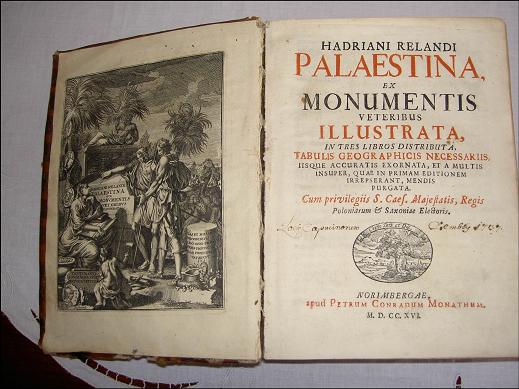... I am visiting Mr. Hobber old books store in Budapest, Hungary. ...The Jewish section is a room full of antiquity books ... sometime, one can find there real culture treasure. Many of the books are Holy Books that may have been stolen from synagogues' archives: Talmud, Bible, Mishnah, old Ashkenazi style Siddur, and others.
...Sometime one can find a bargain such as the book Palestina by Hadriani Relandi -- its original professional name Palaestina, ex monumentis veteribus illustrata, published by Trajecti Batavorum: Ex Libraria G. Brodelet, 1714. One can find such original books in only few places in the world, also in Haifa University.
Follow these links for more information about the book and how to buy a copy:
- http://www.amazon.com/s/ref=nb_sb_noss?url=search-alias%3Dstripbooks&field-keywords=Palaestina%2C+ex+monumentis+veteribus+illustrata&x=14&y=20
- http://lib.haifa.ac.il/departments/nedirim/eng/hadriani.html
- http://books.google.com.au/books/about/Palaestina_ex_monumentis_veteribus_illus.html?id=j5cUAAAAQAAJ&redir_esc=y
- http://www.flipkart.com/books/1120106311
- http://www.borders.com.au/book/hadriani-relandi-palaestina-ex-monumentis-veteribus-illustrata-tomus-i-ii-volume-1/27486020/

He first mapped the Land of Israel. Secondly, Relandi identifies each of the places mentioned in the Mishnah or Talmud along with their original source. If the source was Jewish, he listed it together with the appropriate sentence in the Holy Scriptures. If the source was Roman or Greek he presented the connection in Greek or Latin.
Thirdly, he also arranged a population survey and census of each community.
2. Most of the land was empty, desolate, and the inhabitants few in number and mostly concentrate in the towns Jerusalem, Acco, Tzfat, Jaffa, Tiberius and Gaza. Most of the inhabitants were Jews and the rest Christians. There were few Muslims, mostly nomad Bedouins. Nablus, known as Shchem, was exceptional, where approximately 120 people, members of the Muslim Natsha family and approximately 70 Shomronites, lived.
In the Galilee capital, Nazareth, lived approximately 700 Christians and in Jerusalem approximately 5000 people, mostly Jews and some Christians.
The interesting part was that Relandi mentioned the Muslims as nomad Bedouins who arrived in the area as construction and agriculture labor reinforcement, seasonal workers.
In Gaza for example, lived approximately 550 people, fifty percent Jews and the rest mostly Christians. The Jews grew and worked in their flourishing vineyards, olive tree orchards and wheat fields (remember Gush Katif?) and the Christians worked in commerce and transportation of produce and goods. Tiberius and Tzfat were mostly Jewish and except of mentioning fishermen fishing in Lake Kinneret -- the Lake of Galilee -- a traditional Tiberius occupation, there is no mention of their occupations. A town like Um el-Phahem was a village where ten families, approximately fifty people in total, all Christian, lived and there was also a small Maronite church in the village (The Shehadah family).
3. The book totally contradicts any post-modern theory claiming a "Palestinian heritage," or Palestinian nation. The book strengthens the connection, relevance, pertinence, kinship of the Land of Israel to the Jews and the absolute lack of belonging to the Arabs, who robbed the Latin name Palestina and took it as their own.
In Granada, Spain, for example, one can see Arabic heritage and architecture. In large cities such as Granada and the land of AndalucÃa, mountains and rivers like Guadalajara, one can see genuine Arabic cultural heritage: literature, monumental creations, engineering, medicine, etc. Seven hundred years of Arabic reign left in Spain an Arabic heritage that one cannot ignore, hide or camouflage. But here, in Israel there is nothing like that! Nada, as the Spanish say! No names of towns, no culture, no art, no history, and no evidence of Arabic rule; only huge robbery, pillaging and looting; stealing the Jews' holiest place, robbing the Jews of their Promised Land. Lately, under the auspices of all kind of post modern Israelis -- also hijacking and robbing us of our Jewish history.

2 comments:
That is a fascinating post. Could you try to fix the link in it, I would like to see the other site.
Thanks
Sorry about the broken link. It was in the source article from THINK-ISRAEL. I've now replaced it with several links that provide further information and an opportunity to buy a copy.
Post a Comment